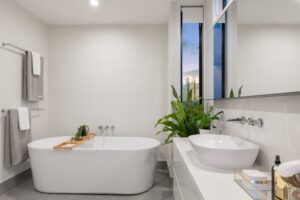Key Takeaways
- Refinishing is best for tables with surface damage like scratches and dullness.
- Refurbishing is ideal for structurally compromised tables needing more extensive repairs.
- Refinishing involves stripping, sanding, and applying a new finish.
- Refurbishing can include refinishing, but also involves structural repairs and potential redesigns.
- Consider the table’s condition, desired outcome, and available resources before choosing a method.
Reviving Your Acacia Wood Table: To Refinish or Refurbish?
Every acacia wood table has a story, and if yours could talk, it might plead for a second chance to shine. Maybe it’s a family heirloom, a flea market find, or simply showing its age. Whatever the case, refinishing or refurbishing can breathe new life into it.
Why Your Acacia Wood Table Deserves Attention
Acacia wood is known for its durability and striking grain patterns, making it a perfect candidate for a makeover. Over time, though, even the most robust acacia wood table can lose its luster. Scratches, stains, and wear can dull its natural beauty. But don’t worry, with a little effort, you can restore your table to its former glory.
What to Know Before Deciding: Refinishing vs Refurbishing
Before diving into the process, it’s essential to understand the difference between refinishing and refurbishing. Refinishing focuses on restoring the table’s surface. This means stripping away the old finish, sanding, and applying a new finish to enhance its appearance. On the other hand, refurbishing can involve refinishing, but it also includes structural repairs and potentially redesigning parts of the table.
Refinishing vs Refurbishing: Quick Match-Up
| Refinishing | Refurbishing | |
| Cost | $50 to $150 | $150 to $400 |
| Timeline | 3 to 7 days | 1 to 3 days |
| Pros | Restores the table’s beauty, prolongs life, cost-effective, removes surface imperfections, sustainable option, provides a sense of satisfaction | Addresses both structural and surface issues, customization, extends the life of table, sustainable, quicker process |
| Cons | Lengthy process, can be labor-intensive, strong fumes from stains and finishes | More expensive, requires more advanced skills, surface imperfections |
Evaluating the Condition of Your Acacia Wood Table
To determine whether to refinish or refurbish, you need to evaluate the condition of your table. This involves a thorough inspection to identify any wear, damage, or structural issues.
Identifying Wear and Damage
Start by looking for surface damage. This includes scratches, stains, and areas where the finish has worn away. These are usually signs that refinishing could be beneficial. Next, check for any deeper damage, such as cracks or splits in the wood. These issues might require more extensive refurbishing.
Assessing Structural and Surface Integrity
Besides surface wear, you should also assess the table’s structural integrity. Check for wobbly legs, loose joints, or any parts that seem unstable. If the table is structurally sound but looks worn, refinishing is likely the way to go. However, if there are significant structural issues, refurbishing might be necessary to ensure the table is both beautiful and functional.
Renewing the Beauty: Refinishing Your Acacia Wood Table
Refinishing is a fantastic way to renew the beauty of your acacia wood table. It focuses on restoring the surface to make it look new again. Here’s when and how you should consider refinishing.
When to Consider Refinishing
Refinishing is ideal for tables with surface-level damage. If your table has scratches, dullness, or minor stains, refinishing can effectively restore its appearance. It’s also a good option if you want to change the color or finish of the table to match a new décor.
Gathering Tools and Materials for Refinishing
Before starting the refinishing process, gather all necessary tools and materials. Here’s a list to get you started:
- Sandpaper (various grits)
- Paint stripper
- Scraper
- Soft cloths
- Wood stain or paint
- Polyurethane or another protective finish
- Brushes and rollers
- Protective gear (gloves, goggles, mask)
The Refinishing Steps
Now that you’ve got your tools and safety gear, let’s dive into the refinishing steps. Roll up your sleeves – it’s time to get to work.
- Prep Work: Before refinishing, gather materials like sandpaper, a sander, wood filler, and a high-quality finish, and start by thoroughly cleaning the table to remove dust and dirt.
- Stripping the Old Finish: Apply a paint stripper to remove the old finish. Follow the instructions on the product, and use a scraper to gently lift the old finish off the wood.
- Sanding: Once the old finish is removed, sand the table using sandpaper. Start with a coarse grit to remove any remaining finish, then move to a finer grit to smooth the surface.
- Staining or Painting: After sanding, wipe the table down with a soft cloth to remove any dust. Then, apply your chosen stain or paint. Allow it to dry completely before moving to the next step.
- Applying a Protective Finish: Finally, apply a protective finish such as polyurethane. This will protect the wood and give it a beautiful shine. Apply multiple coats if necessary, allowing each coat to dry thoroughly.
Benefits of Refinishing
Refinishing an acacia wood table offers several benefits:
- Restores Beauty: Brings back the original luster and rich color of the wood, making the table look new again.
- Prolongs Life: Extends the lifespan of the table by protecting it from further wear and damage.
- Cost-Effective: More affordable than buying a new table, allowing you to maintain high-quality furniture at a lower cost.
- Fixes Surface Imperfections: Removes scratches, dents, and other surface imperfections, improving the overall appearance and condition.
- Environmental Impact: Reduces waste by reusing existing furniture instead of discarding and purchasing new pieces.
- Personal Satisfaction: Provides a sense of accomplishment and pride in restoring a valued piece of furniture yourself.
Common Drawbacks of Refinishing
Refinishing furniture, while beneficial, can come with several drawbacks:
- Time-Consuming: The process can be lengthy, requiring significant time for sanding, staining, and applying multiple coats of finish.
- Labor-Intensive: Refinishing requires substantial physical effort, especially in sanding and handling heavy pieces.
- Fumes and Odors: Some finishes and stains emit strong fumes that require proper ventilation and safety precautions.
Modernizing the Style: Refurbishing Your Acacia Wood Table
Sometimes, your table needs more than just a fresh coat of finish. Refurbishing is a more comprehensive process that can include refinishing but also extends to structural repairs and redesigns. This approach is perfect for tables that have significant damage or if you want to give your table a completely new look.
When Refurbishing is the Best Option
Refurbishing is ideal when your table has structural issues such as wobbly legs, broken parts, or deep cracks. It’s also a great option if you want to modernize the table’s design, perhaps by adding new features or changing its style entirely. Essentially, if the table needs more than just surface work, refurbishing is the way to go.
Essential Tools and Materials for Refurbishing
Refurbishing requires a more extensive set of tools and materials compared to refinishing. Here’s what you’ll need:
- All tools and materials listed for refinishing
- Wood glue
- Clamps
- Replacement wood parts (if needed)
- Wood filler
- Screwdrivers and screws
- Paint or varnish remover (for detailed work)
- Power tools (like a drill or jigsaw) for structural repairs
The Refurbishing Process
Refurbishing involves several steps, each designed to address different aspects of the table’s condition. Here’s a step-by-step guide:
- Disassembly: Carefully disassemble the table to ensure you can reach all areas needing attention. Remove the legs, tabletop, and any other parts for easier individual work.
- Structural Repairs: Inspect each part for structural damage. Use wood glue and clamps to fix any broken pieces. If any parts are beyond repair, replace them with new wood. Ensure all joints are secure and stable.
- Surface Preparation: Thoroughly clean and sand the surface to remove any old finish or imperfections. This preparation ensures the new finish adheres properly.
- Redesign (Optional): If you’re looking to change the table’s design, now’s the time to do it. This could involve cutting new shapes, adding decorative elements, or even changing the table’s height.
- Staining or Painting: Apply your chosen stain or paint. This step is similar to the refinishing process but might require more creativity if you’re going for a new look.
- Reassembly: Once all parts are repaired and finished, reassemble the table. Ensure everything fits together securely and that the table is stable.
Advantages of Refurbishing
Refurbishing an acacia wood table offers several advantages compared to refinishing:
- Addresses Structural and Surface Issues: Refurbishing allows you to address both surface and structural issues, making your table as good as new.
- Customization: Refurbishing offers the flexibility to redesign and modernize the table, giving it a fresh, updated look.
- Sustainable Option: Refurbishing can significantly extend the life of your table. By repairing and updating your existing furniture, you reduce the need for new resources and minimize waste.
Disadvantages of Refurbishing
Refurbishing an acacia wood table, while beneficial, also has some disadvantages compared to refinishing:
- Surface Imperfections: Small imperfections and signs of wear might still be visible, which refinishing would typically remove.
- More Expensive: The cost of materials and replacement parts can add up, making it a more expensive option.
- Requires More Advanced Skills: Refurbishing requires a broader range of skills and tools, making it a more challenging project for beginners.
Refinishing vs Refurbishing: A Side-by-Side Comparison
To help you decide whether to refinish or refurbish your acacia wood table, let’s compare the two methods side by side. This comparison will cover cost, time and effort, durability, and aesthetic appeal.
Cost Analysis
Refinishing is generally more cost-effective since it primarily involves surface work, with costs ranging from $50 to $150. You’ll need sandpaper, stain, and a protective finish, which are relatively inexpensive. In contrast, refurbishing can be more costly due to the need for additional tools, materials, and potentially replacement parts. It could cost around $150 to $400, especially if new hardware is included.
Time and Effort Involved
Refinishing usually takes a bit longer because you need to sand thoroughly, apply multiple coats of stain or finish, and wait for each coat to dry, which can take about 3 to 7 days. On the other hand, refurbishing is generally faster and easier, involving some cleaning, minor repairs, and adding new hardware, which usually takes just 1 to 3 days.
Durability and Longevity
Both refinishing and refurbishing can enhance the durability and longevity of your table. However, refurbishing provides a more comprehensive solution by addressing both surface and structural issues. A refurbished table is likely to last longer and withstand more wear and tear.
Visual and Aesthetic Appeal
Refinishing can restore the natural beauty of acacia wood, highlighting its unique grain patterns. It’s an excellent option if you want to maintain the table’s original look. Refurbishing, however, offers more flexibility in terms of design. You can completely transform the table’s appearance, making it a versatile option for those looking to modernize their furniture.
Making the Right Choice for Your Table
Deciding between refinishing and refurbishing your acacia wood table depends on several factors. You need to consider the table’s current condition, budget, and the desired outcome. Here’s a detailed look at the factors to consider to help you make the right choice.
Condition of the Table: If your table has only surface-level damage like scratches or dullness, refinishing is likely the best option. However, if there are structural issues such as wobbly legs or deep cracks, refurbishing will be necessary.
Desired Outcome: Think about what you want to achieve. If you want to restore the table’s original beauty, refinishing is the way to go. If you’re looking to modernize or redesign the table, refurbishing offers more flexibility.
Budget: Refinishing is generally more cost-effective, while refurbishing can be more expensive due to the need for additional materials and potential replacement parts.
Final Thoughts
Both refinishing and refurbishing have their merits, and the right choice depends on your specific situation. Refinishing is ideal for surface-level damage and maintaining the table’s original look, while refurbishing is better for addressing structural issues and allowing for redesigns. By carefully evaluating your table’s condition and considering your desired outcome, resources, and budget, you can make an informed decision that will breathe new life into your acacia wood table.
Frequently Asked Questions (FAQ)
What is the lifespan of a refinished acacia wood table?
A refinished acacia wood table can last for many years, often up to a decade or more, depending on the quality of the finish and how well it’s maintained. Regular cleaning and occasional touch-ups can help extend its lifespan.
Can I switch from refurbishing to refinishing later?
Yes, you can switch from refurbishing to refinishing later. If you initially refurbish your table to address structural issues, you can always refinish it later to enhance its appearance. Just make sure to follow the proper steps for refinishing, including stripping the old finish and sanding the surface.
How can I ensure a smooth finish without professional tools?
To achieve a smooth finish without professional tools, follow these tips:
- Use high-quality sandpaper and sand in the direction of the wood grain.
- Apply thin, even coats of stain or paint, allowing each coat to dry thoroughly before applying the next.
- Use a soft cloth to wipe away any excess stain or paint for an even finish.
- Apply a protective finish such as polyurethane in thin, even coats, sanding lightly between coats.





Leave a Reply